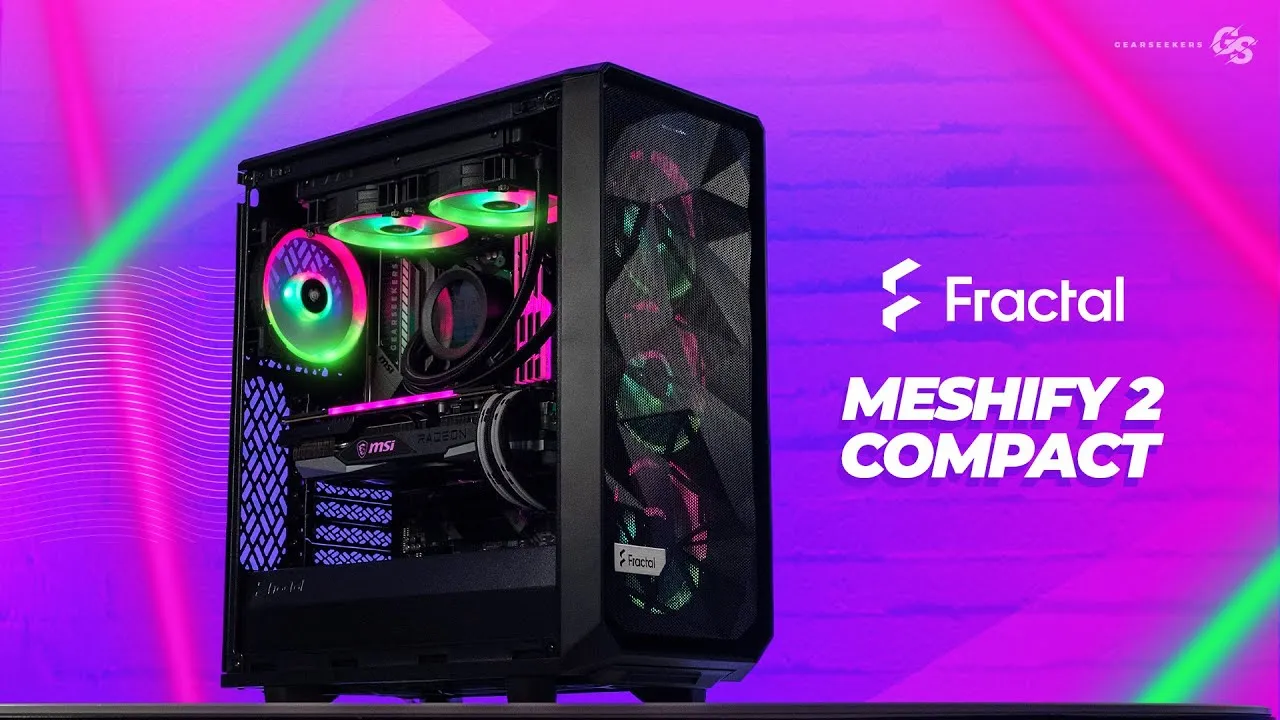Oot on the heels of the Define 7 Compact is another rejigged and miniaturized version of a Fractal ATX case – the Meshify 2 Compact. It retains various design aspects of its bigger sibling, the Meshify 2, but in a chassis that measures just 21cm wide and 42cm deep. It’s not going to threaten many mini-ITX cases, but it’s certainly going to save desk space compared with most ATX cases.
Fractal Meshify 2 Compact ATX Case Review
At $90 inc VAT, it’s a bit cheaper than the Define 7 Compact, presumably due to the mesh front panel using less material than the plastic panel of the latter. That’s the key difference between the two cases, with the Meshify 2 Compact sporting a large angular mesh on the front panel, but also lacking the ability to use a closed roof section. There’s no optional panel in the box as there is with the Define 7 Compact, so you’re stuck with a vented roof. Airflow is the focus of the Meshify 2 Compact, and it doesn’t just have more vents than the Define 7 Compact either. It also sports an additional front 140mm fan, with a pair of fans pushing air into the case compared to just one with the Define 7 Compact.
With a vented front panel, the case lends itself well to water cooling, and the PSU cover has removable plates that offer extended clearance for radiators. There’s more than enough space for a 60mm-thick 280mm or 360mm radiator at the front with a single row of fans, as well as a 240mm radiator in the roof as long as the components on your motherboard sit more than 40mm below the roof.
The mounts in the roof are offset, with Fractal Design giving you as much clearance away from the motherboard as possible. The Define 7 Compact’s party trick is on display here too, with the Meshify 2 Compact able to ditch its entire roof section, including the usual support beam that joins the top two corners of the case. This completely opens up the case and makes a whole bunch of building jobs a lot easier, such as fitting the 8-pin CPU power connector, installing a motherboard or mounting radiators.
Connectivity
The front panel offers a pair of USB 3 ports as well as a USB 3.1 Type-C port, which requires a Type-C header on your motherboard. There’s also power and reset buttons, and a pair of audio jacks fora microphone and headphones.
Panel
Moving down from that panel is the front mesh section. On other meshed cases, the mesh is usually fixed in place, so you have to yank off the whole panel to access filters beneath it, or to mount extra fans or radiators. However, the Meshify 2 Compact allows you to remove the mesh section separately, leaving the plastic frame behind. It’s easier to pull off than your typical front panel, and gives full access to the fan mounts beneath. There’s even a pull-out dust filter as an added layer of protection behind the front mesh, and an additional dust filter in the base of the case.
The narrow width of the case means there’s not a particularly deep space for stowing cables behind the motherboard tray, but it’s at least easy to tidy, with six Velcro ties ready to secure cables and plenty of other anchor points for cable ties. Thankfully, the rubber grommets that surround the numerous cable-routing holes proved particularly resilient to popping out too.
There aren’t too many stand-out features in terms of storage, with a pair of dedicated 2.5in SSD mounts along with two 2.5in/3.5in bays in the base, which are fairly typical of cases this size. Meanwhile the CPU cooler clearance is decent at 169mm, as is the graphics card cooler clearance of 341mm. As you might expect, though, there’s no E-ATX motherboard support and you’ll need to use a PSU that measures 165mm long or shorter if you intend to use the hard disk mounts and front fan. However, removing the drive trays opens up this area to 200mm of clearance.
Performance
We expected better temperatures compared with the Define 7 Compact, given the addition of a front mesh and extra front fan, and sure enough, the Meshify 2 dropped the CPU delta T by 4°C from 54°C to 50°C. That result is right up there with the best-performing cases we’ve seen, such as the be quiet! Pure Base 500DX and NZXT 510 Elite with its highest fan speed, but warmer than the Antec DF700 FLUX’S excellent result of 47°C.
Meanwhile, the GPU delta T of 4TC was one degree cooler than the Define 7 Compact, though, which makes sense seeing as it also has a fan pointed at its GPU, albeit with slightly restricted airflow. Overall, the Meshify 2 Compact is certainly a very capable case out of the box and the fan noise was extremely quiet at full speed, despite the Meshify 2 Compact’s meshed front potentially allowing more sound to escape than the Define 7 Compact’s solid panel.
Conclusion
The Fractal Design Meshify 2 Compact is very similar to the Define 7 Compact in terms of features and layout. The latter may look a little smarter with its closed front panel, but the Meshify 2 Compact is still extremely quiet, and the benefit in airflow is clear, with a much lower CPU delta T than the Define 7 Compact, and the GPU cooling was a little better too. If you’re not fussed by the Define 7 Compact’s closed front, the Meshify 2 Compact is definitely the better of the two cases, especially as it’s otherwise identical and costs less money.
The other cases to bear in mind in this price range are the likes of the be quiet! Pure Base 500DX and Antec DF700 FLUX. Both are cheaper than the Meshify 2 Compact, and also offer RGB lighting, but only the Antec managed to offer better cooling, and that was just a few degrees knocked off the CPU delta T.
The Meshify 2 Compact beats them both in terms of easy building and size though. If you have around $100 to spend on a PC case, these cases should occupy the top three slots on your shortlist – it’s then a matter for your priorities.An excellent compact case that’s great out of the boxand has scope for a decent water-cooling system.

